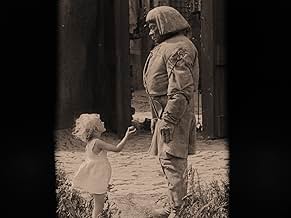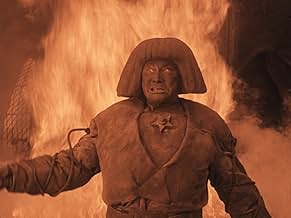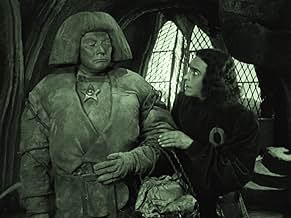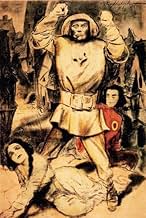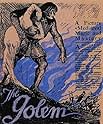IMDb RATING
7.2/10
9.1K
YOUR RATING
In 16th-century Prague, a rabbi creates the Golem - a giant creature made of clay. Using sorcery, he brings the creature to life in order to protect the Jews of Prague from persecution.In 16th-century Prague, a rabbi creates the Golem - a giant creature made of clay. Using sorcery, he brings the creature to life in order to protect the Jews of Prague from persecution.In 16th-century Prague, a rabbi creates the Golem - a giant creature made of clay. Using sorcery, he brings the creature to life in order to protect the Jews of Prague from persecution.
- Directors
- Writers
- Stars
- Awards
- 1 win & 1 nomination total
Hans Stürm
- Der Rabbi Jehuda, der Älteste der Gemeinde
- (as Hans Sturm)
Carl Ebert
- Temple Servant
- (uncredited)
Fritz Feld
- Jester
- (uncredited)
Loni Nest
- Ein kleines Mädchen
- (uncredited)
- …
Ursula Nest
- Little Girl
- (uncredited)
Dore Paetzold
- Des Kaisers Kebse
- (uncredited)
- …
Märte Rassow
- Kind
- (uncredited)
- Directors
- Writers
- All cast & crew
- Production, box office & more at IMDbPro
Featured reviews
This is, currently, the only silent movie I have ever seen, and I was unsure how I'd take it. I had heard a lot about this movie and was expecting big things, and I must say I was impressed.
The only major complain I have is that, as with many older classics, I read a review of it prior to buying in which the reviewer gave WAY too much away (the ending sequence, namely).. this has happened to me far too many times. I really wish reviewers wouldn't assume that everyone has already seen the movies they are reviewing, just because they are 'classics'. It really dampened my experience with the ending of both this movie, and The Man with X-Ray Eyes, just to name a few.
Anywho, the version I saw (the Kino remaster) was great. The picture quality was about as good as you could expect from a film more than 80 years old. The score was very good, maybe a tad repetitive, but it suit the film. The acting is quite good, very reminiscant of the acting style from the mid-to-early 20th century.
The scare factor? Well, probably not much these days. The Jewish ghetto is very well constructed, and really suits the setting. The golem himself is not so scary, more goofy to me, but to people in 1920, I can imagine he could have been quite scary. This is more of an 'interest' movie, than an all-out scare fest. You can really see where so many of the great horror/scare films over the years got their ideas from after seeing early films such as this.
I would definately recommend everyone who is interested in horror to track it down. Don't be put off by the fact that it's a silent film, it took all of 20 seconds for me to forget that completely, and to just enjoy the film.
The only major complain I have is that, as with many older classics, I read a review of it prior to buying in which the reviewer gave WAY too much away (the ending sequence, namely).. this has happened to me far too many times. I really wish reviewers wouldn't assume that everyone has already seen the movies they are reviewing, just because they are 'classics'. It really dampened my experience with the ending of both this movie, and The Man with X-Ray Eyes, just to name a few.
Anywho, the version I saw (the Kino remaster) was great. The picture quality was about as good as you could expect from a film more than 80 years old. The score was very good, maybe a tad repetitive, but it suit the film. The acting is quite good, very reminiscant of the acting style from the mid-to-early 20th century.
The scare factor? Well, probably not much these days. The Jewish ghetto is very well constructed, and really suits the setting. The golem himself is not so scary, more goofy to me, but to people in 1920, I can imagine he could have been quite scary. This is more of an 'interest' movie, than an all-out scare fest. You can really see where so many of the great horror/scare films over the years got their ideas from after seeing early films such as this.
I would definately recommend everyone who is interested in horror to track it down. Don't be put off by the fact that it's a silent film, it took all of 20 seconds for me to forget that completely, and to just enjoy the film.
Although this 1920 German silent does not really rank alongside the truly great silent films, it remains a fascinating oddity. Based on European Jewish folklore, it tells the story a Jewish community in Prague which is threatened with expulsion from the city. In an effort to protect his people, Rabbi Loew creates a man-like creature made of clay and uses it to impress the Emperor. Unfortunately, the magic backfires, and when the Golem falls into the hands of the Rabbi's perfidious assistant disaster results.
Much of the film's charm is in its visual style. The sets by Hans Poelzig are a strange but cohesive mixture of medieval, nouveau, and surrealism, and the cinematography by legendary photography Karl Freund uses high contrast black and white to truly remarkable effect. The Poelzig-Freund combination would cast an extremely long shadow, and THE GOLEM would influence not only such German films as Fitz Lang's METROPOLIS but the entire cycle of 1930s American horror films that began with the 1931 Bela Lugosi Dracula.
Several plot devices and the look of the Golem, as played by Paul Wegener, would also prove particularly influential for director James Whale's famous 1932 FRANKENSTEIN. Whether or not Boris Karloff or make-up artist Jack Pierce knew the film is uncertain--but Whale, who was fond of German cinema, certainly did, and traces of THE GOLEM can be seen throughout his most famous works.
Over the past several decades a number of film historians have attempted to reinterpret THE GOLEM in light of the Holocaust. There may actually be a certain validity to this, for although the Jews are portrayed sympathetically they are very clearly outsiders, and their religion seems less like religion than witchcraft--and indeed Rabbi Loew might be said to practice black magic in bringing the Golem to life. This sense of social estrangement and religious stigmatism does seem indicative of the anti-Semitism that will ultimately explode into furnaces of Nazi Germany. All the same, it is worth noting that THE GOLEM is a fundamentally Jewish story to begin with, and it is perhaps best to think of it in those terms instead of using hindsight to impose modern meanings upon the film.
There are several home market releases of the film. While I have not seen it, I am told the Timeless Studios VHS release is weak; I have, however, seen the Gotham DVD release, and although there are some quality issues this inexpensive DVD is not at all bad. Still, my preference and recommendation is the Kino DVD. Unlike many Kino editions, it does not have anything significant in the way of bonuses, but the overall presentation is very fine and likely represents a best-possible presentation short of full digital restoration.
Much of the film's charm is in its visual style. The sets by Hans Poelzig are a strange but cohesive mixture of medieval, nouveau, and surrealism, and the cinematography by legendary photography Karl Freund uses high contrast black and white to truly remarkable effect. The Poelzig-Freund combination would cast an extremely long shadow, and THE GOLEM would influence not only such German films as Fitz Lang's METROPOLIS but the entire cycle of 1930s American horror films that began with the 1931 Bela Lugosi Dracula.
Several plot devices and the look of the Golem, as played by Paul Wegener, would also prove particularly influential for director James Whale's famous 1932 FRANKENSTEIN. Whether or not Boris Karloff or make-up artist Jack Pierce knew the film is uncertain--but Whale, who was fond of German cinema, certainly did, and traces of THE GOLEM can be seen throughout his most famous works.
Over the past several decades a number of film historians have attempted to reinterpret THE GOLEM in light of the Holocaust. There may actually be a certain validity to this, for although the Jews are portrayed sympathetically they are very clearly outsiders, and their religion seems less like religion than witchcraft--and indeed Rabbi Loew might be said to practice black magic in bringing the Golem to life. This sense of social estrangement and religious stigmatism does seem indicative of the anti-Semitism that will ultimately explode into furnaces of Nazi Germany. All the same, it is worth noting that THE GOLEM is a fundamentally Jewish story to begin with, and it is perhaps best to think of it in those terms instead of using hindsight to impose modern meanings upon the film.
There are several home market releases of the film. While I have not seen it, I am told the Timeless Studios VHS release is weak; I have, however, seen the Gotham DVD release, and although there are some quality issues this inexpensive DVD is not at all bad. Still, my preference and recommendation is the Kino DVD. Unlike many Kino editions, it does not have anything significant in the way of bonuses, but the overall presentation is very fine and likely represents a best-possible presentation short of full digital restoration.
When I see these old attempts at what amounted to a horror film back then, before my time and I'm an old duffer, I'm always struck at the marvelous Gothic quality wrought by the twisted buildings, the gnarled stairways, the open balconies and the weird angles of things such as doorways, arches, street, bridges and the like. The monstrosities are stark, hardly terrifying by today's CGIs and often terrifying their victims in an almost comical, stylized way. This marvelous film together with Nosferatu and The Cabinet of Dr. Caligari are marvelous pieces of art. There is an ageless quality to them that transcends the hoary and often corny plots and acting. Each must be taken as a whole because that product is always greater than the sum of their parts. Compare the magical Indian Love Call of Nelson Eddy and Jeanette MacDonald, two rather mainstream singers whose voices blend into something greater than either of their individual talents. So too it is, I contend, with these old Gothic classics. Horror? Hardly. But, their starkness and darkness with its twisted surroundings are still eerie and provoking.
The giant frame of Paul Wegener as the Golem is one of the best known characters from the silent era, and one of the first icons of horror. Der Golem is actually the third film to feature the character, the first being The Golem (1915), and the second The Golem And The Dancing Girl (1917), which is a short comedy with Wegener donning the costume to frighten a girl he is in love with. Tragically, those two films are now considered lost, and only fragments equalling about 14 minutes of the first film remain. This film is actually a prequel, and it's full title is Der Golem: Wie Er In Die Welt Kam (How He Came Into The World), but is now commonly know as simply Der Golem.
The Jews of medieval Prague face persecution from the townsfolk. Terrified of their doomed fate, Rabbi Loew (Albert Steinruck) uses his skills in black magic to create The Golem, a mythical figure from Jewish folklore. He is made entirely from clay, and has an amulet in his chest that gives him power, and when removed turns him back into lifeless clay. He is initially used as a servant, and then to terrify the townsfolk who are threatening them. The Golem eventually gets tired of being used as a tool of fear and begins to turn on his creator, and starts to lay waste to the Ghetto.
Like the majority of films made in Weimar Germany, the film has an expressionist tone, with lavish, artistic sets that dominate the frame. Similar in feel to the great Das Cabinet Des Dr. Caligari, it is however more subtle in its artistic flair, and lacks Caligari's rickety (although wonderful in its own way) sets. It is also quite terrifying in its realisation of a segregation that would occur in the country only a decade later, although it does portray the Jews as vengeful and as studying the dark arts.
The Golem itself is a great movie monster. Tragic in the same way as Frankenstein's monster, he is brought into the world without having asked to be, and is expected to carry out terrible acts against his will. Paul Wagener portrays him with all silent intensity and uncontrollable rage, with his towering frame sending his enemies running for the hills. He also impressively co-wrote and co-directed the film. This is an enjoyable film that breezes by in its rather slight running time, and can be forgiven for some over-acting and the occasional tedious scene. It also has some interesting social comments, and is a frightening prelude to one of the most horrific periods in Europe's history.
www.the-wrath-of-blog.blogspot.com
The Jews of medieval Prague face persecution from the townsfolk. Terrified of their doomed fate, Rabbi Loew (Albert Steinruck) uses his skills in black magic to create The Golem, a mythical figure from Jewish folklore. He is made entirely from clay, and has an amulet in his chest that gives him power, and when removed turns him back into lifeless clay. He is initially used as a servant, and then to terrify the townsfolk who are threatening them. The Golem eventually gets tired of being used as a tool of fear and begins to turn on his creator, and starts to lay waste to the Ghetto.
Like the majority of films made in Weimar Germany, the film has an expressionist tone, with lavish, artistic sets that dominate the frame. Similar in feel to the great Das Cabinet Des Dr. Caligari, it is however more subtle in its artistic flair, and lacks Caligari's rickety (although wonderful in its own way) sets. It is also quite terrifying in its realisation of a segregation that would occur in the country only a decade later, although it does portray the Jews as vengeful and as studying the dark arts.
The Golem itself is a great movie monster. Tragic in the same way as Frankenstein's monster, he is brought into the world without having asked to be, and is expected to carry out terrible acts against his will. Paul Wagener portrays him with all silent intensity and uncontrollable rage, with his towering frame sending his enemies running for the hills. He also impressively co-wrote and co-directed the film. This is an enjoyable film that breezes by in its rather slight running time, and can be forgiven for some over-acting and the occasional tedious scene. It also has some interesting social comments, and is a frightening prelude to one of the most horrific periods in Europe's history.
www.the-wrath-of-blog.blogspot.com
In 16th-century Prague, a Jewish rabbi (Albert Steinrück) creates a giant creature from clay, called the Golem, and using sorcery, brings the creature to life in order to protect the Jews of Prague from persecution.
Called "one of the most ambitious productions of the silent era" by Mike Mayo, the film is a blend of religion, astrology and black magic -- mixing Judaism with a conjuring of the demon Astaroth.
The film also has an interesting presentation of anti-Semitism, where the emperor accuses the Jews of killing Christ, among other things, and orders them to evacuate the ghetto. How did Germany in 1920 feel about the Jews? We now know how they felt a decade later, but was this hatred always there or invented by Hitler? If it existed, how did it translate to this film's reception by the German people?
Paul Wegener's face is a wealth of visions -- he manages to use his eyes in such a way that present the golem as simultaneously stoic and intensely emotional.
Others have pointed out that Karl Freund's camera is remarkably still for a man who would go on to be known for the most innovative camera techniques in film history (I dare say he is the greatest cinematographer who ever lived). Mayo says there is an "inventive use of extreme camera angles", but I did not notice. The lack of movement does not hinder the film, however.
Lee Price praises the film, saying the only fault of the film is "the inconsistency of the acting", though I did not find it distracting at all (even if the frightened faces of the extras are a bit extreme). Price calls the architecture of the film as influential (or more so) than the German Expressionism of "Caligari". He is not alone in this view: Ivan Butler makes a point to mention the "strange twisted buildings and crooked streets filled with steeple-hatted inhabitants", and Siegfried Kracauer singles out the "maze of crooked streets and stooped houses" devised by Professor Hans Poelzig.
If you are to see or own this film, I recommend the Kino DVD. Not only is the film cleaned up nicely, with a wonderful score and English title cards, but the supplements are beyond what one would expect from such an old film -- featurettes comparing this movie to "Faust" and the later "Le Golem". I enjoyed them.
Called "one of the most ambitious productions of the silent era" by Mike Mayo, the film is a blend of religion, astrology and black magic -- mixing Judaism with a conjuring of the demon Astaroth.
The film also has an interesting presentation of anti-Semitism, where the emperor accuses the Jews of killing Christ, among other things, and orders them to evacuate the ghetto. How did Germany in 1920 feel about the Jews? We now know how they felt a decade later, but was this hatred always there or invented by Hitler? If it existed, how did it translate to this film's reception by the German people?
Paul Wegener's face is a wealth of visions -- he manages to use his eyes in such a way that present the golem as simultaneously stoic and intensely emotional.
Others have pointed out that Karl Freund's camera is remarkably still for a man who would go on to be known for the most innovative camera techniques in film history (I dare say he is the greatest cinematographer who ever lived). Mayo says there is an "inventive use of extreme camera angles", but I did not notice. The lack of movement does not hinder the film, however.
Lee Price praises the film, saying the only fault of the film is "the inconsistency of the acting", though I did not find it distracting at all (even if the frightened faces of the extras are a bit extreme). Price calls the architecture of the film as influential (or more so) than the German Expressionism of "Caligari". He is not alone in this view: Ivan Butler makes a point to mention the "strange twisted buildings and crooked streets filled with steeple-hatted inhabitants", and Siegfried Kracauer singles out the "maze of crooked streets and stooped houses" devised by Professor Hans Poelzig.
If you are to see or own this film, I recommend the Kino DVD. Not only is the film cleaned up nicely, with a wonderful score and English title cards, but the supplements are beyond what one would expect from such an old film -- featurettes comparing this movie to "Faust" and the later "Le Golem". I enjoyed them.
Did you know
- Trivia"Aemaet", the life-giving word which Rabbi Lowe compels from the spirit Astaroth is also reflected in the bolts of lightning at the end of the creation scene.
- GoofsThe story is set in the 16th Century. A prediction of doom is made based on the movements of Uranus, which was not discovered until 1781.
- Alternate versionsThe 2002 Alpha Video DVD version runs for 101 minutes. This is not evident from the back of the Alpha Video DVD case, which wrongly lists the running time as only 85 minutes. It looks as if Alpha Video somehow got hold of the fullest version currently known - maybe even a complete version of the film, since there are no obvious gaps in the story.
- ConnectionsEdited into People Who Die Mysteriously in Their Sleep (2004)
- How long is The Golem?Powered by Alexa
Details
- Runtime1 hour 16 minutes
- Color
- Sound mix
- Aspect ratio
- 1.33 : 1
Contribute to this page
Suggest an edit or add missing content



